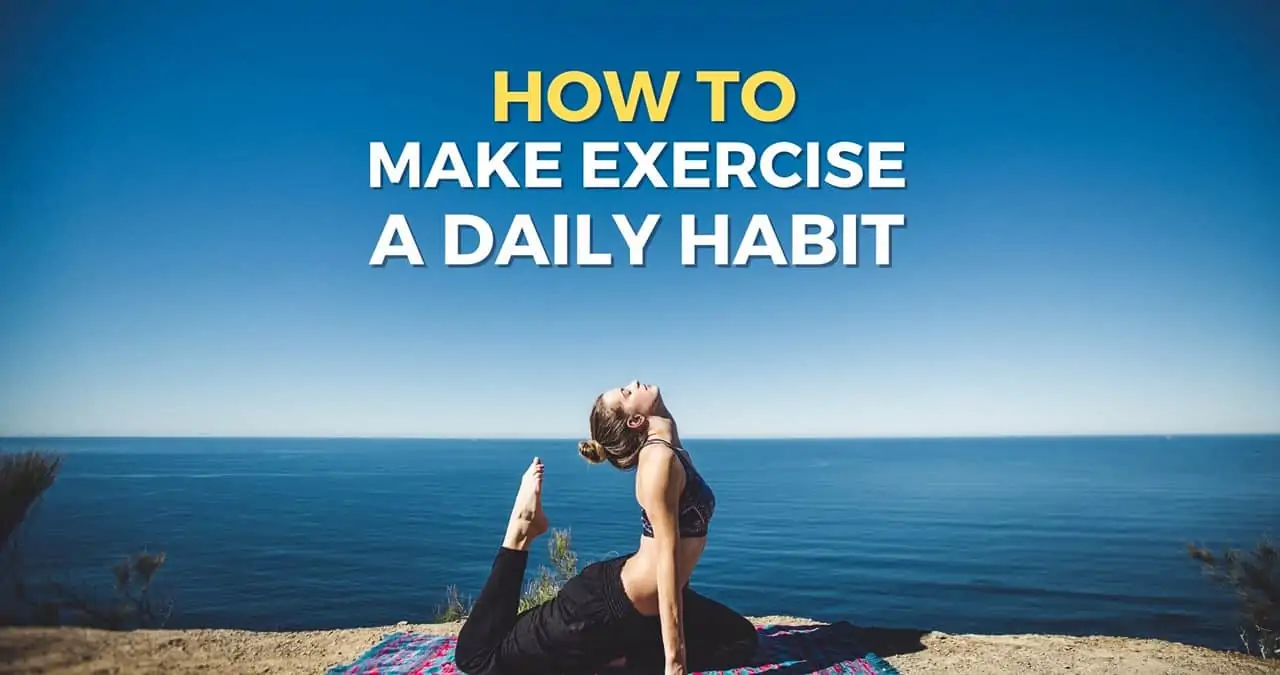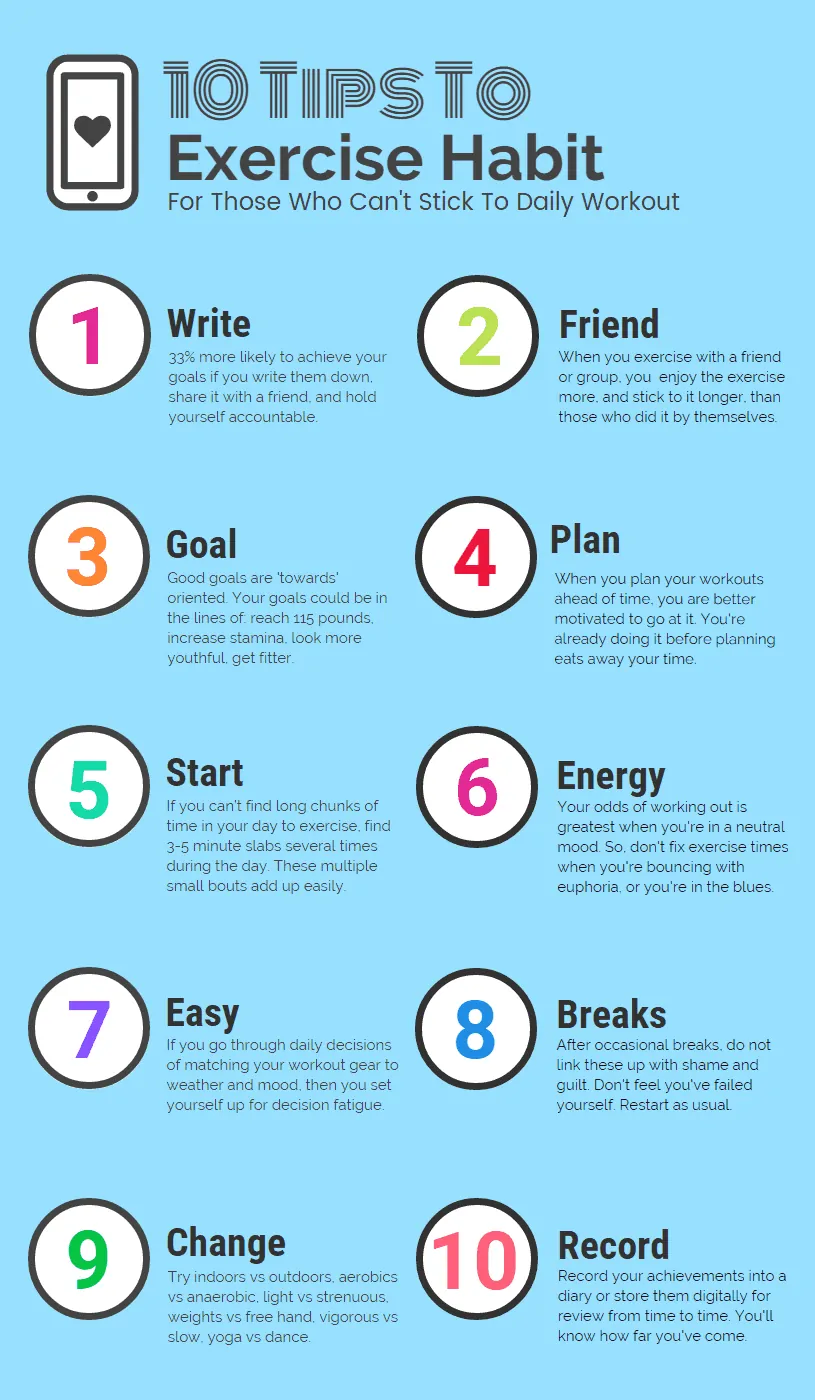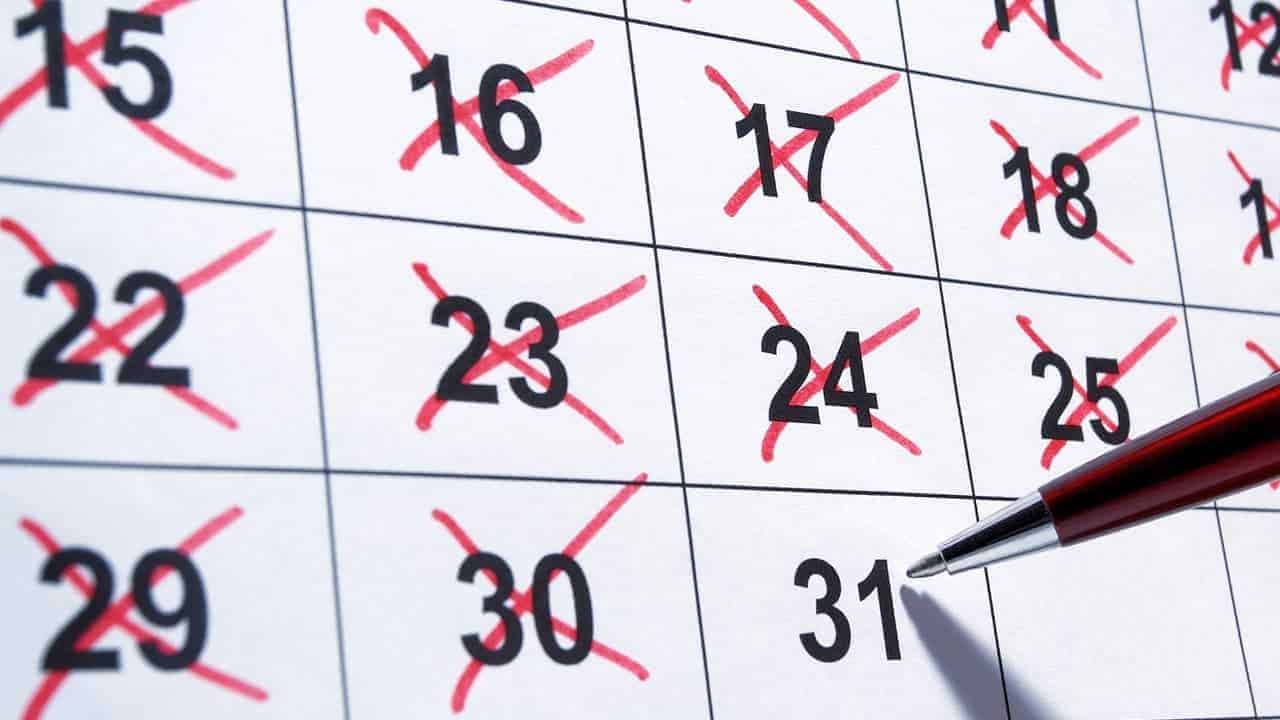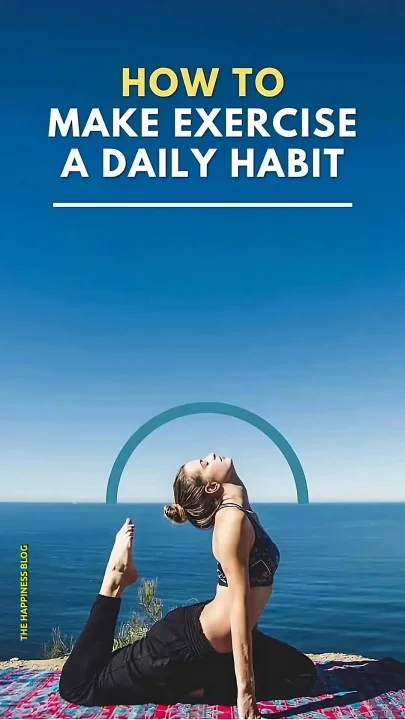Today's Wednesday • 16 mins read
— By Dr. Sandip Roy.
A shocking 25.3% of American grown-ups aren’t active, even when they know that exercise protects from heart disease, diabetes, and early aging. Knowing isn’t enough.
Facts don’t get us to act. We’re great knowers, but poor doers.
Then, almost half of those who say they’re going to exercise don’t do it, even if they mean to. This is the intention-behavior gap. In practice, 47.6% of people who intended to be active did not end up doing so (Feil & Fritsch, 2022).
So, the biggest barriers to exercise aren’t knowledge or motivation, but a lack of strategies for turning intentions into habits.
Experts recommend that every grown-up exercise for ~30 minutes a day, 5 days a week. That’s just 2.5 hours per week, or 10 hours a month.
The following 10 strategies will help you get a non-negotiable exercise habit. Even if you miss a few days, you can get back on track.
1. Write Down A Commitment
Intentions alone don’t work. Intentions are fantasies without deadlines.
Don’t tell yourself:
- “I’ll start this weekend as soon as the work pressure is less.”
- “I must start exercising this week.”
- “I’ll work out later.”
Instead, write down your goals with dates/times. It removes the feel-good fantasies of “I will” and “I must.” Neuroscience says writing your goals increases your commitment and accountability.
Here is a simple breakdown of this strategy:
- Make a daily exercise schedule. Be specific about the type, time, and duration of your workout.
- Share it with a friend or family member. Ask them to hold you accountable.
- Set a reminder to review your exercise plan the night before.
- Set an alarm for the next morning.
A Sample Commitment:
- 8:00-8:15 AM: Warming up exercises
- 8:15-8:30 AM: Jogging or running
- 8:30-8:45 AM: Breathing exercise

2. Find A Workout Buddy or Join A Group
If you work out with a friend or join a fitness group, you’re more likely to stick with it.
Benefits of working out with others:
- Motivation: Seeing others working hard can motivate you to push yourself harder.
- Accountability: When you commit to someone else, you’re less likely to skip.
- Support: Workout buddies and fitness groups support and encourage you.
- Fun: Exercising with others can be more fun than exercising alone.
Research suggests group walks in nature can reduce depression and stress.
Ask a friend, family member, or neighbor to join you. Or find people to work out with at a gym, online, in running groups, or in yoga classes.
- Look for someone with similar fitness goals and interests.
- Find someone reliable and committed to working out.
- Make sure you have fun working out with them!
If you cannot find a workout partner, make a No-Contact Exercise Buddy.
Do this: Pick someone you see jogging every day. Promise yourself that you’ll jog today so that you can beat them in six months. Repeat it the next day.
A few tips to stay motivated while working out alone:
- Set realistic goals.
- Track your progress.
- Find activities you enjoy.
- Reward yourself for your accomplishments.
3. Set Positive Or Approach (“Towards”) Goals
“Towards-goals” are better than “away from” goals.
- Approach (“toward”) goals ask us to move toward a desired outcome. They are about gaining something positive, such as increasing stamina, looking more youthful, or getting fitter.
- Avoidance (“away from”) goals try to push us away from an undesired outcome. They focus on moving away from negative things, such as decreasing tiredness, appearing less haggard, or being less sedentary.
Research confirms that approach goals are more effective than avoidance goals (Mann, de Ridder, Fujita, 2013). This is because approach goals are associated with greater positive emotions, thoughts, and self-evaluations and greater psychological well-being (Coats & Janoff-Bulman, 1996).
Some approach goals (“towards goals”) vs. avoidance (“away from goals”) goals:
- Approach goal: I will achieve my ideal weight of 115 pounds (ca. 52 kg).
Avoidance goal: I will lose 25 pounds (ca. 11 kg). - Approach goal: I will get fitter by lifting 10-pound weights.
Avoidance goal: I will stop being unfit. - Approach goal: I will increase my stamina so I can run for 3 minutes without stopping.
Avoidance goal: I must stop getting exhausted within a minute of jogging. - Approach goal: I will reverse my aging by taking the right food and supplements.
Avoidance goal: I will avoid looking older than my age. - Approach goal: I will only eat a healthy diet starting today.
Avoidance goal: I will have to stop my unhealthy eating lifestyle.
Tips for setting approach goals:
- Set a specific date for achieving your goal.
- Be specific about what you want to achieve.
- Make sure your goal is realistic, yet stretches you a little.
- Break your goal down into smaller, more manageable steps.
- Track your progress and celebrate your small successes with self-rewards.
To set such effective goals, take a look at these 3 Goal-Setting Techniques.
4. Plan Your Workouts Ahead Of Time (AOT)
A highly effective way to stick to an exercise plan is to plan your workouts ahead of time (AOT). When you know what you’re going to do and when you’re going to do it, you’re less likely to skip your workouts.
Some tips for creating an AOT plan:
- Choose a mix of activities. This will help keep your workouts interesting and challenging. Harvard T.H. Chan School of Public Health recommends activities like brisk walking, using a pedometer, and combining cardiovascular exercise with sedentary activities (like exercising while watching TV).
- Mix and match different types of workouts. For example, you could do a strength training workout on Monday, a cardio workout on Wednesday, and a yoga class on Friday.
- Schedule your workouts in advance. Put them in your calendar or planner so you can’t forget.
- Be flexible. Things happen, so don’t be afraid to adjust your plan if needed.
Clarity in AOT Planning: If your AOT plans are clear and detailed, you’ll more likely stick to your exercise goals.
Sample AOT (Ahead Of Time) weekly plan:
- Monday: Strength Training
- Tuesday: Light Aerobic Activity
- Wednesday: Cardio Workout.
- Thursday: Flexibility and Balance
- Friday: Slow-movement exercise like yoga
- Saturday: Meditation and introspection
- Sunday: Rest and Recovery
5. Start Slow & Small Before Building Up
A tiny amount of exercise is better than none. Intensity and extra time can come later.
For the first few weeks, set small workout goals so you don’t get too stressed out or give up.
Tips when getting started:
- Start with just 5–10 minutes of exercise per day.
- Focus on one body part or muscle group per day.
- Choose activities that you enjoy: dancing is a great exercise!
- Work out in small chunks. Say, 5 minutes of walking in the morning, 10 sit-ups at lunchtime, and 3 minutes of yoga before bedtime.
Some examples of small chunks of exercise:
- Take a walk around the block.
- Do a few push-ups and sit-ups.
- Climb the stairs instead of taking the elevator.
- Do some stretching or yoga after 30 minutes of sitting.
- Park further away from your destination and walk the rest of the way.
On the lighter side, find a person who can’t fit three 1-minute bursts of exercise into a day, and you’ve found the world’s laziest dodo.

6. Exercise During Your Peak Energy Times
Morning workouts are more effective for weight management than evening workouts. That’s because for most of us, mornings are our high-energy times.
A 2023 study found overweight men who did 30 minutes of moderate-intensity cardio three times a week lost more weight and had lower body fat after six weeks if they worked out in the morning.
Experts tell us that our chances of exercising are highest when we are in a neutral mood — not too excited, not too down. Avoid scheduling workouts when you’re feeling too happy or too sad.
Some tips for making morning workouts work for you:
- Go to bed and wake up at the same time each day, even on weekends. This will help regulate your sleep-wake cycle and make it easier to get out of bed in the morning.
- Get some sunlight exposure as soon as you wake up. Sunlight kickstarts your wakefulness and helps boost your energy levels and alertness.
- Eat something light (not a full breakfast) before your workout to power your workout without feeling too full.
- Start your workout slowly and gradually increase the intensity.
- Listen to your body and take breaks when needed.
However, morning may not be your peak energy time. Find yours.
Notice when you feel most alert, active, and sharp during the day. Afternoon and evening workouts work great for many people.
7. Make Exercise Easy and Accessible
Make exercising as easy as possible. Embrace the path of the least resistance.
Tips to remove physical and mental blocks:
- Lay out your workout clothes the night before. This saves time and energy, thus reducing the likelihood of skipping exercise due to decision fatigue.
- Go to bed in your workout clothes. It may seem like an extreme measure, but it works. Wear your jogging dress to bed, so you can roll out of bed and move into your workout without any fuss. It removes any barriers between you and your workout. When you wake up, you’re already halfway there!
- Choose activities you enjoy. Break the routine every week or two to do some physical activity that you really love to do (for me, it’s walking around my own city like a tourist). Try dancing, hiking, or Zumba. Breaks from monotony make routines more sticky.
- Integrate exercise into your lifestyle. Try “sneaking” more movement into daily life. Some daily movement tips: house chores, extra steps, taking the stairs, chair stretching, and moving after meals.
Some daily movement tips:
- Dance Interludes: Do a short dance while doing routine tasks like cooking or cleaning. This adds fun to your chores and increases your activity level.
- Parking Farther Away: Whenever you drive somewhere, park farther away from the entrance. This simple change adds extra walking to your routine, boosting your daily step count.
- Active TV Watching: During TV show commercials or streaming pauses, do quick exercises like sit-ups, push-ups, or jumping jacks.
- Walking Meetings: If possible, conduct meetings or phone calls while walking. This can be especially effective for one-on-one meetings or when on a personal call.
- Bike for Errands: For close-by tasks, take a bike ride instead of driving, which gives you a chance to get some fresh air and is environmentally friendly.
- Gardening or Yard Work: Engage in gardening or yard work, which beautifies your living space and involves physical labor that’s great for fitness.
- Stand Up Regularly: If you work at a desk, make it a habit to stand up and stretch or walk around every hour. This helps in reducing the risks associated with prolonged sitting.
Then there’s “habit stacking” to push you further on your path of least resistance. Habit Stacking means adding a habit to another pre-existing routine. Some examples:
- Before breakfast, do a short cardio session, like jumping jacks or a brisk walk, to help kick-start your metabolism.
- After returning from work, do a stretching or yoga session as a way to decompress from the day and shift into home mode.
- Before your usual nighttime activities like reading or watching TV, a light exercise, like Tai Chi, can help you relax and improve your sleep quality.
8. Integrate Regular, Planned Breaks
Those who can actively control their behavior and avoid distractions are 58% more likely to follow through. One practical way to support self-control is to plan intentional breaks into your routine.
Even the most conscientious exercisers need to take breaks from time to time. There will be days when you’re not feeling up to working out, or when you have other commitments that take priority.
In fact, scheduling occasional breaks into your fitness routine can be a good way to stay motivated and avoid burnout. It can also give your body time to rest and recover.
Here are a few tips for filling in occasional breaks in your fitness routine:
- Plan your breaks ahead of time. This will help you avoid skipping workouts on impulse.
- Schedule a day off every week or ten days. This will give your body time to rest and recover.
- Listen to your body. If you’re feeling tired or sore, take a break. Don’t push yourself too hard.
- Find other ways to be active. If you’re not feeling up to a hard workout, go for a walk, do some yoga, or play with your kids.
Of course, the most essential thing is to stay consistent with your exercise routine. But don’t be afraid to take breaks when needed.
9. Vary Your Exercise Patterns
There’s a song by King Prawn called Lick of the Flame which has these lines:
Mundane monotony is all you have to offer me.
Don’t let your workout become a mundane, routine activity that you end up dreading. Try changing it up. Here are a few ideas:
- Change the environment. Exercise indoors or outdoors, depending on your preference.
- Change the type of exercise. Alternate between aerobic and anaerobic exercises, or between light and strenuous exercises.
- Change the equipment you use. Lift weights instead of doing freehand exercises, or vice versa.
- Change the intensity of your workouts. Try vigorous workouts one day and slow workouts the next.
- Try a new activity. Take a yoga class, go for a dance lesson, or try a new sport.
Changing up your workout routine can also help you challenge yourself and improve your fitness results.
10. Keep A Record of Your Achievements
This is worth repeating: People who monitor their behavior and stay conscious of their goals are 91% more likely to exercise as planned (Feil & Fritsch, 2022).
Write them into a diary or store them digitally for review from time to time. You could use a digital notepad for this.
Notes:
- I did 10 minutes of slow-run and 2 minutes of fast-run.
- I will add one minute of jumping jacks and 5 pull-ups tomorrow.
William Arruda, the author of the great book Ditch, Dare, Do, says it in three simple words in his Forbes post, The One Thing Successful People Do Every Day:
Document your wins.

Using Psychology To Turn Intention Into Exercise
Three psychological factors make the most decisive difference in whether you’ll actually follow through:
- Awareness: People who monitor their own behavior and stay conscious of their goals are 91% more likely to exercise as planned.
- Self-regulation: Those who can actively control their behavior (saying no to distractions) are 58% more likely to follow through.
- Self-efficacy: Believing you can actually complete the workout increases follow-through by 44%.
This research shows exactly how to bridge the gap between intention and action:
- Schedule workouts in your calendar like important meetings. Decide exactly when and where.
- Create accountability by working out with a friend or sharing your goals with others.
- Set reminders on your phone to increase your awareness throughout the day.
- Start with workouts you know will work.
What To Do When You Fail Going To Exercise
Missing a day or two of a workout is a small part of your life. Don’t make it worse by self-criticism.
Exercise is a journey, not a race. The idea is to go back to it like you never left it.
If skipping exercise still makes you feel guilty, try these:
- Practice Self-Compassion: Be gentle with yourself. Building a habit is a process. Slow progress and setbacks are part of the journey. Celebrate small victories, forgive small slip-ups.
- Adjust Expectations: Your exercise routine is a personal journey, not a competition. Set your goals based on your capabilities, not others’ standards. Try keeping up the routine, in however small a way.
- Positive Self-Talk: Have an uplifting self-dialogue the night before. Try putting up Post-it notes with positive affirmations at various places, such as a mirror, desk, and car dashboard.
- Visualize Success: Spend 1–2 minutes each day visualizing yourself having achieved your fitness goal, like standing before the mirror, sweating, and satisfied.
- Reward Progress: Set up a system of rewards for having met your goals, especially in the beginning. This could be a simple, healthy snack like a protein bar.
- Don’t be afraid to change your plan. It may be that your chosen gym or particular workout set is too hard or too exhausting afterward. If that’s the case, try something else.
- Listen to your body. If you’re feeling tired even after taking a few days off, consult your medical doctor.
Consult Your Doctor: Consult your doctor before starting any exercise program. Certain exercises may not be medically safe for you. Don’t overexert yourself on a dare, especially if you are over 30 years of age.
How Long To Make An Exercise Habit Stick?
Experts say it can take anywhere from 21 to 66 days to form a new exercise habit.
- 21 Days: In Psycho-Cybernetics, Maxwell Maltz wrote, “Many other commonly observed phenomena tend to show that it requires a minimum of about 21 days for an old mental image to dissolve and a new one to jell.”
- 66 Days: Phillippa Lally, a researcher in health psychology at University College London, carried out a study in 2009 that said it takes a little more than 2 months (or 66 days) for a new habit to take root.
- 49 Days: Ryan Brooks combined Charles Duhigg’s The Power of Habit and the X Effect Method to reach the figure of 49 days. He says, “So, once you have completed 49 days straight with little slip-ups, you can be sure to have developed a positive habit, or broken a bad habit.”

Final Words
Download: How To Make Exercise A Daily Habit (PDF).
It’s really the follow-through that falls through. Motivation is unreliable, but systems are sustainable. For any kind of success, persistence outperforms motivation every time.
Don’t just think, “I’ll work out later.” Instead:
- Start so small that you can’t skip it.
- Find your peak energy and neutral mood times.
- Get back to your routine like you never missed a day.
• • •
√ Also Read: 7 Habits (Foods & Exercises) For Mental Fitness.
√ Please share it with someone if you found this helpful.
» You deserve happiness! Choosing therapy could be your best decision.
...
• Disclosure: Buying via our links earns us a small commission.
